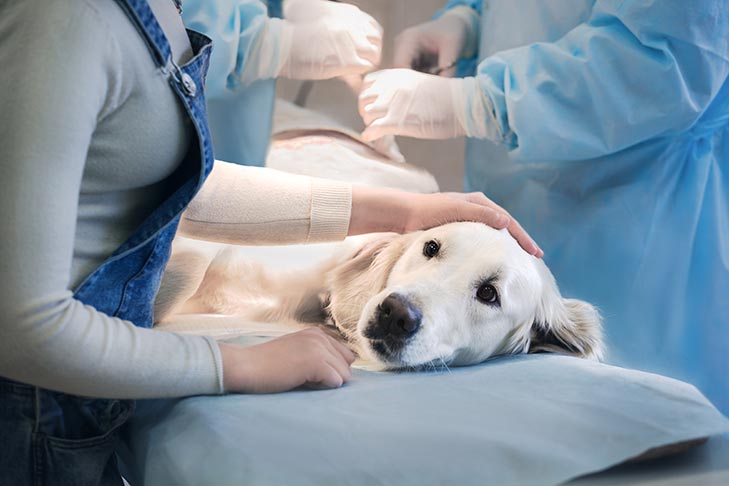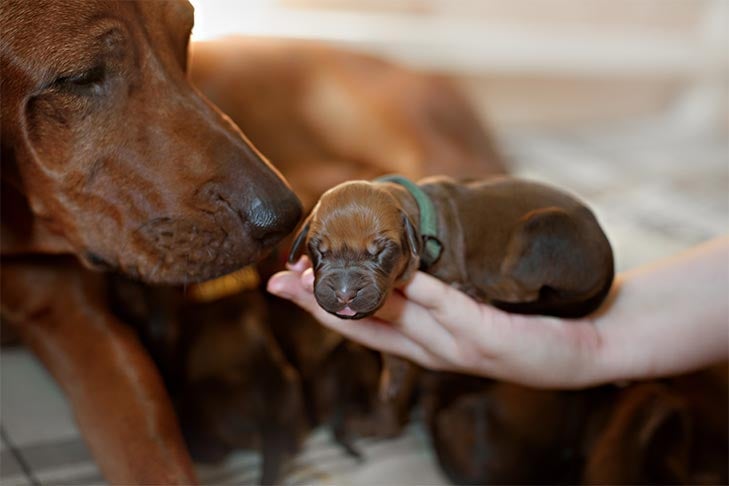Not all conditions are easy to physically identify, and lumps in different places could mean different conditions. If you’ve ever seen a puppy with a bulding belly button, or a lump near your dog’s inner thigh or anus, it could be a sign of a hernia. But what is a hernia, and what does it mean when your dog has one?
What Are Hernias in Dogs?
Hernias in dogs are actually quite common. Aside from there being a bulge where there shouldn’t be one, what exactly are they? Just as in people, a hernia occurs when an organ or tissue protrudes through a tear or hole in the wall of a body cavity and appears in a different area from where it should normally be. Not all hernias are life-threatening, but they should still be checked by a veterinarian, as there is a risk of strangulation, interruption, or obstruction to the blood supply to the organ trapped in the hernia. If a hernia is small and involves fat rather than a vital organ or tissue, your veterinarian might recommend closely monitoring the hernia. However, because there is always the worry that an organ could become involved, so surgical correction is often recommended.

According to Dr. Jerry Klein, Chief Veterinary Officer for the AKC, there are different types of hernias, classified depending on their location in the body. The five types are:
- Diaphragmatic Hernias: These are named for the diaphragm, a sheet of muscle that separates the heart and lungs from the abdominal organs. When a tear or hole appears in that muscle, abdominal organs like the stomach can press up into the chest cavity. For this type of hernia, you wouldn’t see any external bulges or lumps, because it’s happening inside the body.
- Hiatal Hernias: These also involve the diaphragm, but in this case, the hernia appears in the natural opening where the esophagus and the stomach meet. The stomach or other abdominal organs can protrude through the opening, leaving no externally visible bulge.
- Inguinal Hernias: These involve abdominal organs protruding through the inguinal canal, which is a small opening in the muscles of the groin area. These show up as a bulge in the inner crease where the dog’s hind leg attaches to their belly.
- Perineal Hernias: These involve a rupture in the muscles of the pelvic diaphragm, which is a wall in the lower abdomen that separates the abdominal organs from the rectum. An organ such as the prostate or bladder can push through the rupture to appear just below the skin. These hernias appear as a swelling in the area around the anus.
- Umbilical Hernias: These occur around the dog’s umbilicus or belly button. They involve the abdominal fat or a portion of the abdominal organs pushing out around the navel. They look like a bulge on the stomach and are located just under the dog’s rib cage.
What Causes Hernias in Dogs?
Although hernias can appear in many different places and affect various organs, Dr. Klein explains there are three main causes. “Some hernias in dogs are genetic, some are secondary to trauma, and some are secondary to an underlying medical condition, such as pregnancy or straining to defecate.”
A genetic or congenital hernia is present at birth. All hernia types can occur this way, but umbilical hernias, the most common type of hernia, are always congenital. While the fetus is developing in the mother’s uterus, blood vessels from the mother pass through an opening in the fetus’s abdominal muscles known as the umbilical ring. Normally, that ring closes after birth, but in some puppies, it remains partially open, allowing organs to slip through.

Secondary hernias can happen if the dog has a traumatic injury, like being hit by a car. Any internal tears resulting from the collision, such as in the diaphragm, can lead to the displacement of organs. Animal bite wounds, such as from a dog fight or attack by a wild animal, can also lead to a secondary hernia if the teeth of the other animal tear the internal muscular layer while leaving the skin fairly intact. Finally, underlying medical conditions can lead to secondary hernias. For example, if a dog has frequent constipation and strains to defecate, it can contribute to a perineal hernia by stressing the muscles in the pelvic diaphragm. Or chronic esophagitis (when the esophagus becomes inflamed) may be related to the development of a hiatal hernia.
Are Some Breeds More at Risk for Hernias?
Because hernias can result from trauma or from health concerns, like dog obesity or constipation, any dog is at risk. However, there are factors that increase that risk in certain dogs. For example, inguinal hernias are more common in pregnant dogs because the weight of the puppies in the uterus can stretch the inguinal canal. And although hiatal hernias can happen because of trauma, they are usually congenital. A study from the University of Bristol indicates that the Chow Chow and Chinese Shar-Pei, as well as some brachycephalic dog breeds, have a higher incidence of being born with hernias.
What Are the Signs of Hernias in Dogs?
Along with the different types of hernias, they also come in varied sizes, and can appear in different locations in the body. Because of this, the signs the help identify hernias can differ. In some cases, like a small umbilical hernia, there may be no symptoms other than a bump. In other cases, you may see behavioral or physical signs. There are symptoms that are typically associated with each type of hernia:
- Diaphragmatic hernias impact the chest cavity, so you may see your dog taking rapid and shallow breaths.
- Inguinal hernias can cause difficulty peeing if the bladder is trapped in the hernia.
- Hiatal hernias involve the stomach, so they can cause vomiting, bloody vomit, regurgitation, drooling, and trouble breathing.
- Perineal hernias may result in your dog straining to poop.
- Umbilical hernias, in rare cases, can trap an organ such as the bowel, bladder, or small intestine. That will strangulate the organ (cut off the blood supply), necessitating emergency surgery. In such a situation, your dog will experience pain, which can lead to lethargy, loss of appetite, nausea, or vomiting.

How Are Hernias Treated?
According to Dr. Klein, there are different approaches to treating a hernia. “Surgical correction and reduction of most hernias are recommended to prevent further complications. Some small umbilical hernias may be able to be manually reduced until a time when surgical reduction of the hernia is performed,” he says. The treatment changes depending on the size and type of the hernia. “Diaphragmatic hernias are considered life-threatening and require surgical correction. Hiatal hernias can be treated medically to control mild signs or surgically to resolve the hernia.”
Can Hernias Be Prevented in Dogs?
You can’t prevent congenital hernias because your dog is born with them. But you can reduce your dog’s risk of trauma-induced hernias resulting by supervising your dog and maintaining a safe environment both indoors and out. Things that seem simple, like teaching your dog your yard boundaries or making sure they listen when called can help in a situation where they might be tempted to run into the road can make a huge difference. When they aren’t in a fenced-in area or indoors, keep your dog on a leash and practice good leash manners. This will help keep your dog under control even if they are distracted by outside factors.

When Do You Need to Call Your Vet?
Hernias can, but don’t always exhibit external buldges, and symptomgs can range from none to emergency-level distress. It’s important to see your veterinatrian if you notice any lumps or anything off about your dog’s health or behavior. Your vet will diagnose a hernia using physical examination, palpation of the affected area, and imaging, like X-rays, to see inside your dog’s body. Then, based on the type of hernia diagnosed, your vet will recommend appropriate treatment.
This article is intended solely as general guidance, and does not constitute health or other professional advice. Individual situations and applicable laws vary by jurisdiction, and you are encouraged to obtain appropriate advice from qualified professionals in the applicable jurisdictions. We make no representations or warranties concerning any course of action taken by any person following or otherwise using the information offered or provided in this article, including any such information associated with and provided in connection with third-party products, and we will not be liable for any direct, indirect, consequential, special, exemplary or other damages that may result, including but not limited to economic loss, injury, illness or death.

